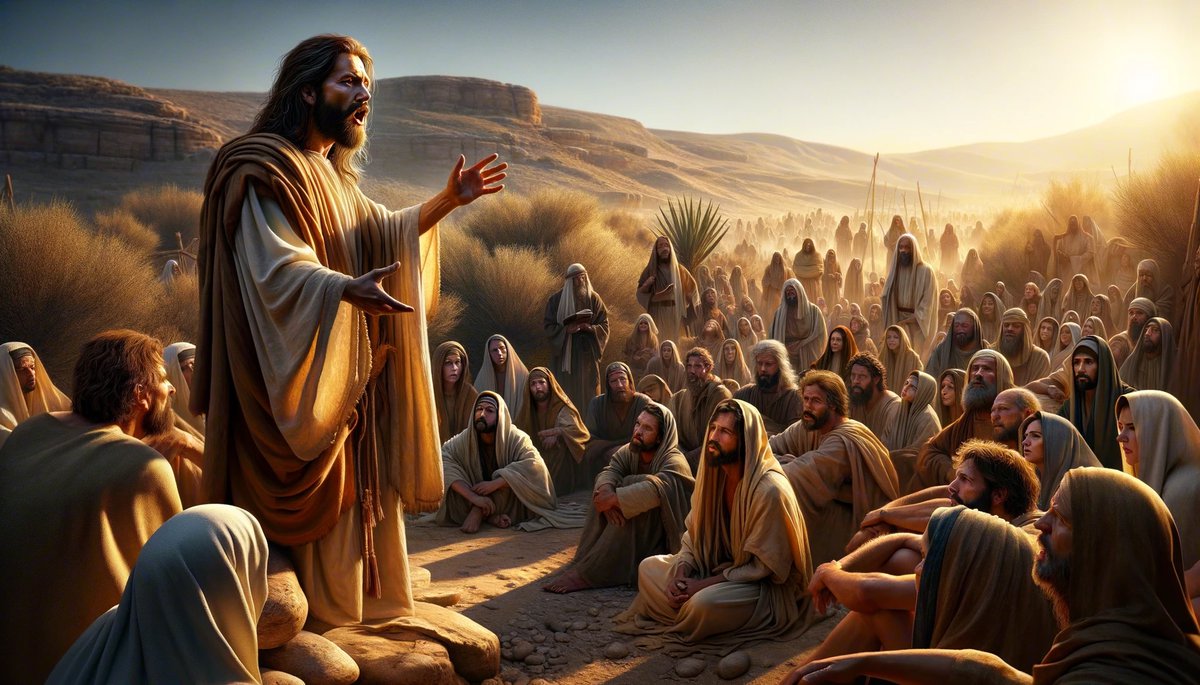Home>Christian Videos>Bible Stories>Where Is The Head Of John The Baptist


Bible Stories
Where Is The Head Of John The Baptist
Published: March 6, 2024
Jason DeRose, Managing Editor at Christian.net, uses his expertise in religion and journalism to deepen understanding of faith's societal impacts. His editorial leadership, coupled with a strong academic background, enriches the platform’s diverse content, earning him recognition in both journalism and religious circles.
Discover the intriguing tale of the whereabouts of John the Baptist's head in this captivating Bible story. Explore the mystery and significance of this historical account.
(Many of the links in this article redirect to a specific reviewed product. Your purchase of these products through affiliate links helps to generate commission for Christian.net, at no extra cost. Learn more)
Table of Contents
Introduction
Where is the head of John the Baptist? This question has intrigued scholars, historians, and religious enthusiasts for centuries. The mystery surrounding the location of John the Baptist's head has sparked numerous theories, investigations, and legends. As a pivotal figure in Christianity and Islam, the search for the whereabouts of his head has captured the imagination of people around the world. In this article, we will delve into the biblical account of John the Baptist's death, explore the historical search for his head, examine the theories and legends surrounding its location, and discuss modern-day investigations and discoveries related to this enigmatic quest. Join us on this fascinating journey as we unravel the mystery of the head of John the Baptist.
Read more: Who Got John The Baptist Head
The Biblical Account of John the Baptist's Death
The biblical account of John the Baptist's death is found in the New Testament, specifically in the Gospels of Matthew (14:1-12) and Mark (6:14-29). According to these accounts, John the Baptist was a prominent preacher who baptized Jesus Christ. He openly criticized the immoral behavior of King Herod Antipas, which ultimately led to his imprisonment. During a lavish banquet held by Herod, his stepdaughter Salome danced for the king and his guests. Herod was so pleased with her performance that he promised to grant her any request, up to half his kingdom. Prompted by her mother, Salome asked for the head of John the Baptist on a platter. Despite his reluctance, Herod, bound by his oath and the pressure of his guests, ordered the execution of John the Baptist. This brutal act fulfilled the request of Salome and led to the beheading of John the Baptist. The biblical narrative portrays John the Baptist as a fearless prophet who faced persecution and martyrdom due to his unwavering commitment to truth and righteousness.
- John the Baptist, a prominent preacher and baptizer of Jesus Christ.
- Criticized the immoral behavior of King Herod Antipas.
- Imprisoned and later executed at the request of Salome during a banquet held by Herod.
- His beheading fulfilled the request of Salome and led to his martyrdom.
This biblical account sets the stage for the historical and theological significance of John the Baptist's life and death, laying the foundation for the enduring mystery surrounding the whereabouts of his head.
The Historical Search for John the Baptist's Head
The historical search for John the Baptist's head has been a compelling quest that has captivated the interest of scholars, theologians, and historians throughout the ages. Following the martyrdom of John the Baptist, the whereabouts of his head became a subject of fascination and reverence. The early Christian tradition revered relics associated with saints and martyrs, and the head of John the Baptist was no exception. The search for his head led to the emergence of various accounts, legends, and purported discoveries, each contributing to the enduring mystery surrounding this relic.
-
Early Christian Veneration:
- The early Christian community held a deep reverence for relics associated with revered figures, believing in their spiritual significance and the power they held. The relics, including the head of John the Baptist, were venerated and sought after as tangible connections to the divine and as sources of miraculous intervention.
-
Relic Traditions and Pilgrimages:
- The veneration of relics, including the head of John the Baptist, gave rise to pilgrimage traditions, with believers journeying to sites associated with the saint in the hope of receiving spiritual blessings and healing. The circulation of relics across different regions further fueled the search for John the Baptist's head, as various locations claimed to possess this revered relic.
-
Byzantine and Crusader Era:
- During the Byzantine and Crusader periods, the quest for relics, including those attributed to John the Baptist, intensified. The Byzantine Empire and the Crusader states vied for possession of sacred relics, and the head of John the Baptist was among the highly coveted treasures. This fervent pursuit contributed to the proliferation of claims regarding the location of the relic.
-
Relic Disputes and Fragmentation:
- The search for John the Baptist's head was accompanied by disputes and controversies surrounding the authenticity of relics purported to be associated with the saint. Fragmentation of relics and the emergence of multiple alleged heads of John the Baptist further complicated the historical search, leading to skepticism and scholarly scrutiny.
-
Enduring Mystique:
- Despite the passage of time, the historical search for John the Baptist's head continues to intrigue scholars and historians, with ongoing debates and investigations seeking to unravel the enigma surrounding this revered relic. The enduring mystique of the relic has left an indelible mark on religious history, inspiring a legacy of exploration and inquiry into the fate of John the Baptist's head.
The historical search for John the Baptist's head reflects the intersection of religious devotion, historical inquiry, and the enduring allure of sacred relics, underscoring the profound impact of this quest on the religious imagination and historical consciousness.
Theories and Legends Surrounding the Location of John the Baptist's Head
The quest to locate the head of John the Baptist has given rise to a myriad of theories and legends, each contributing to the enduring mystery surrounding this revered relic. Throughout history, numerous accounts and claims have emerged, offering diverse perspectives on the possible whereabouts of John the Baptist's head. These theories and legends have woven a rich tapestry of narratives, blending historical inquiry, religious devotion, and folklore, shaping the collective imagination and perpetuating the enigma of the saint's relic.
-
Relic in Constantinople:
According to certain traditions, the head of John the Baptist found its resting place in Constantinople, the capital of the Byzantine Empire. The Byzantine emperors purportedly possessed the relic, elevating its significance and fostering veneration among the faithful. This theory gained prominence during the medieval era, intertwining the relic with the grandeur and spiritual authority of the Byzantine Empire. -
Relic in Amiens, France:
Another prominent theory revolves around the presence of John the Baptist's head in Amiens, France. The Cathedral of Amiens claimed to safeguard the relic, attracting pilgrims and believers who sought the intercession and blessings associated with the revered relic. The alleged presence of the relic in Amiens contributed to the city's religious prominence and served as a focal point for spiritual devotion. -
Multiple Claimants:
The search for John the Baptist's head has been complicated by the emergence of multiple locations and institutions laying claim to the relic. Various churches, monasteries, and noble families asserted possession of the revered relic, leading to conflicting accounts and disputes. The proliferation of claimants added layers of complexity to the historical search, fueling speculation and intrigue surrounding the true location of the relic. -
Legends of Hidden Relics:
Legends and folklore have perpetuated the mystery of John the Baptist's head, with tales of hidden relics and clandestine preservation. These legends often depict dramatic narratives of concealment, miraculous interventions, and the preservation of the relic from desecration. Such stories have contributed to the enduring allure of the relic, inspiring fascination and imaginative interpretations of its potential whereabouts. -
Archaeological Speculation:
In modern times, archaeological speculation and scientific inquiry have sought to shed light on the historical and geographical trajectory of the relic. Scholars and researchers have engaged in rigorous investigations, utilizing historical records, forensic analysis, and archaeological methods to discern the plausible locations associated with John the Baptist's head. These endeavors represent a convergence of scholarly rigor and technological advancements in the pursuit of unraveling the relic's enigmatic journey through history.
The theories and legends surrounding the location of John the Baptist's head reflect the intricate interplay of historical narratives, religious traditions, and human fascination with sacred relics. As the quest for the relic continues to inspire exploration and contemplation, the enduring allure of the saint's head persists as a testament to the enduring legacy of John the Baptist in religious history.
Modern-Day Investigations and Discoveries
In contemporary times, modern-day investigations and discoveries have brought a renewed focus on unraveling the mystery of John the Baptist's head. Advancements in technology, historical research, and interdisciplinary collaboration have propelled efforts to shed light on the elusive relic and its historical trajectory. These endeavors represent a convergence of scholarly inquiry, scientific analysis, and archaeological exploration, aiming to discern the truth behind the enigmatic fate of the saint's head.
-
Forensic Analysis and DNA Testing:
Modern forensic techniques and DNA testing have been employed to examine purported relics associated with John the Baptist. Scientific analysis of bone fragments and ancient remains has sought to establish genetic connections and verify the authenticity of relics attributed to the saint. Through meticulous examination and comparative studies, researchers have endeavored to trace the lineage and provenance of the relics, offering insights into their historical veracity. -
Historical Documentation and Archival Research:
Scholars and historians have delved into historical documentation and archival research to trace the movements and custodianship of relics purported to be the head of John the Baptist. By scrutinizing medieval manuscripts, chronicles, and accounts of pilgrimage, researchers have sought to reconstruct the provenance and transmission of the relic across different epochs. This historical detective work has provided valuable context for understanding the cultural, religious, and political dynamics that shaped the narrative of the relic. -
Archaeological Expeditions and Site Exploration:
Archaeological expeditions and site exploration have sought to identify potential locations associated with the deposition and veneration of John the Baptist's head. Excavations at religious sites, monasteries, and historical landmarks have aimed to uncover tangible evidence and artifacts linked to the relic's presence. The interdisciplinary approach of archaeologists, historians, and theologians has facilitated a comprehensive investigation into the material culture and spatial context of the relic's historical journey. -
Interdisciplinary Collaborations and Academic Symposia:
Interdisciplinary collaborations and academic symposia have fostered dialogue and exchange among experts from diverse fields, including history, archaeology, theology, and genetics. These collaborative efforts have facilitated the sharing of research findings, methodological insights, and scholarly perspectives, enriching the discourse on the quest for John the Baptist's head. By fostering a multidisciplinary approach, these initiatives have advanced the collective understanding of the relic's significance and its place within the broader context of religious material culture. -
Public Engagement and Educational Outreach:
Public engagement and educational outreach initiatives have sought to raise awareness and foster dialogue about the historical and cultural significance of relics, including the head of John the Baptist. Museums, academic institutions, and religious organizations have organized exhibitions, lectures, and public forums to engage diverse audiences in the exploration of relic veneration, historical inquiry, and the intersection of faith and material heritage. These initiatives have contributed to a broader appreciation of the relic's enduring legacy and its resonance within contemporary society.
The modern-day investigations and discoveries surrounding the quest for John the Baptist's head exemplify the enduring fascination with sacred relics and the pursuit of historical truth. Through the integration of scientific advancements, scholarly rigor, and public engagement, these endeavors continue to illuminate the enigmatic journey of the relic, enriching our understanding of its historical, religious, and cultural significance.
Conclusion
The quest for the head of John the Baptist has traversed the realms of history, religion, and human curiosity, weaving a tapestry of narratives, theories, and investigations that continue to captivate the imagination. From the biblical account of his martyrdom to the historical search for his revered relic, the enduring mystery surrounding the whereabouts of John the Baptist's head has left an indelible mark on religious history. The interplay of early Christian veneration, pilgrimage traditions, relic disputes, and modern-day scientific inquiry reflects the profound impact of this quest on the religious imagination and historical consciousness. As the enigma of the relic persists, the convergence of scholarly rigor, technological advancements, and public engagement underscores the enduring fascination with sacred relics and the pursuit of historical truth. The quest for the head of John the Baptist stands as a testament to the enduring legacy of the saint and the enduring allure of relics in shaping the cultural, religious, and historical landscape.














